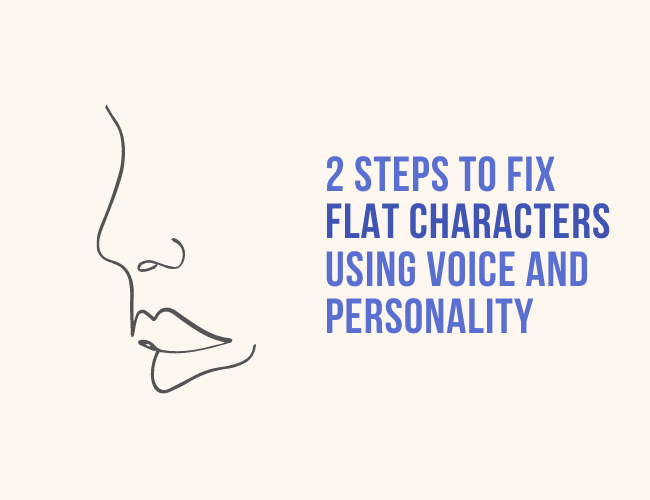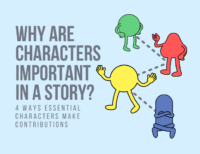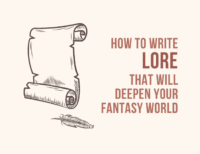You have created a character. You’ve named them and given them a colorful past, as well as lots of fun personality traits. Your character steps into your story . . . and suddenly you find that they aren't working. Have you created a flat character?

Sometimes a flat character shows up as a minor character who may or may not have a full character arc. Sometimes though, it's a main character who has a full arc, but something's wrong.
Those personality traits you meticulously picked out for them just aren't showing up. Your character goes through the motions of the story and you wonder why this interesting, unique character you’ve worked so hard on is missing that luster you imagined.
Simple Character vs Complex Character
Is there such a thing as a “simple character”?
One might argue that a simple character is a bad character. Or at least, badly written. This is not entirely true, though there is some merit to it.
To me, simple characters are those for whom character development is not important. These are not meant to be memorable characters and if they have complex personalities, they are not important to the story.
There is a place for these characters and it is the background. These are not your central characters—your Sherlock Holmes, Elizabeth Bennet, or Luke Skywalker. These minor characters are often not even named.
They're your pedestrians and single-appearance seat fillers, two-dimensional characters who often appear only once to serve the purpose of adding atmosphere or showcase some type of human behavior that only needs to be displayed once.
Anyone within your main character cast, though, should fall into the category of “complex character.”
Some make the mistake of thinking that if a character is a “simple person,” then they are a simple character. Consider the real world: real people are never simple. Any person you stop on the street is able to tell you a long, fascinating story of their life. Even someone who has lived the most mundane of existences experiences deep emotions and possesses a multi-faceted personality. Real people are not flat people.
Creative writing classes will differ on the types of characters used in story writing, but the truth is, no matter the character type, it's unavoidable that any character who plays a key role in the story must be complex to some degree.
2 Steps to Fix Flat Characters
There are many ways to fix flat characters, but in this article, we are going to focus on one method—the easiest and most effective one, which is to give your character a voice.
A voice is how your character perceives the world around them. Everything they are and have been through shows through their voice. Did they have an abusive family that made them pessimistic and angry? Do they have a headstrong nature and tend to question authority?
A voice also shows what your characters want (or don't want). A detective with a desire for justice might be reminded of his past failures when he encounters an obstacle in solving a crime. A young person with a desire for intimacy would probably often notice the people with traits they're attracted to in a crowd.
Having a voice quickly makes a character identifiable and unique and takes them from being a static character to a dynamic character. Not giving your character a clear voice and personality is a common problem. But there is actually a very simple fix. Here's the secret:
Your story is not just about the things your character sees or the events that take place. In order to convey personality and voice, take a close look at your character's reactions. How they react to things will betray their nature and reveal their internal conflicts.
Ready to see it in action? There's a simple two-step process to use reactions to boost flat characters.
Step 1: Decide on Your Character’s Personality
Let’s take the following scenario: your character has arrived on a blind date and is sitting down and evaluating their date—a middle-aged woman—for the first time.
Loni was in her mid-forties, with shoulder-length brown hair. She wore a blue dress white flowers and carried a Gucci purse. She smiled at me when I sat down. We ordered the house wine and each had a glass.
This scene is set, but it tells the reader nothing about your character. Since the story is in first person, your reader is riding inside your character’s head, and yet, they probably feel distant because all they’re seeing is what anyone could see—there is a woman who is at a table, and there is wine.
To make this scene more interesting, think about your character’s personality and their emotional state at that moment.
Is your character a middle-aged man tired of dating who didn’t want to be there? An older woman on her first date after losing her previous partner years ago, a little nervous but excited?
Is your character someone extravagant who enjoys the nightlife and finer things? Or a miser who is more worried about how much this date will cost?
Once you know who your character is, you can move on to the next step.
Step 2: See From Your Character’s Eyes
Once you have decided on who your character is, you can adjust the scene according to their personality.
Let’s take the scene from above, first from the perspective of Character A, who is a jaded middle-aged man who has been dating for a while and has become mistrustful of the whole process. He's also tired of spending money on dates that never seem to go anywhere and isn't sure he is even interested in future relationships.
I slid into my seat across from Loni. She was pretty enough, I guess. Brown hair, nice smile—but then, I’ve never met a woman without a nice smile, no matter what was behind it. Her dress, a blue shift with white flowers, was modest but fit well, which told me she cared enough to look nice but didn’t want to give any impression that the evening might lead further than the dinner table. As we ordered, I eyed her Gucci purse and mused for a moment that if she could afford such a nice accessory, maybe she ought to help pay for dinner. At least she ordered the same wine as me—the cheapest house red.
Do you suddenly find yourself in Character A’s eyes looking out?
Let’s try another one. Character B is a woman re-entering the dating world after a long stint being single. She’s a little excited, feels flirtatious, and hopes to find someone to click with. She also has a healthy appreciation for finer things.
I settle into the chair across from Loni and casually turn my best side—my left side—toward her. She smiles and wow, her teeth are perfect and straight. She asks me about my day and I can’t help watching the light glisten in her honey-brown hair. The dress she has on is a cute blue piece with white flowers. Did she know my favorite color was blue? I like to think it was more than a coincidence. It hugs her curves just right. I watch her blush as she awkwardly sifts through her purse—Gucci, such good taste—for a chapstick. She is adorably flustered and I hope it’s because of me. The restaurant’s wine selection is a bit poor so we go with the house red. Perhaps for our next date, I’ll take her somewhere nicer and teach her about good wine.
Now the same scene has become two vastly different versions. Even though nothing is ever said directly about Characters A and B in these passages, the reader has a clear vision of their personality and mood, all based on how they each view their date with Loni.
Showing, Not Telling a Character's Personality
Like I said above, showing a character’s personality boils down to one thing:
Your character’s personality is reflected in how they react to everything outside of them.
Who is your character? Not just their likes and dislikes, but their perspective, their attitude, their hopes and dreams and fears and concerns. What emotional state are they carrying with them into a scene? And how will they respond to the scene because of that?
Explore those reactions, and you'll find your characters aren't flat at all, but full, three-dimensional people, popping out from the page.
Do you struggle with writing flat characters? What do you do to fix them? Let us know in the comments.
PRACTICE
Pick a character from the following list (or create your own):
- A happy, positive person in a good mood
- A tired old person feeling gloomy
- A child very confused by adults
- A person feeling flirtatious and lustful
- A person who is late and in a rush
Pick one of the following scenarios (or create your own):
- A busy train station with too many people crowding
- A leisure walk in the park
- A curious exploration of an abandoned building
- A very boring day at work/school
- A lively family dinner
Spend fifteen minutes writing the scene from your character’s perspective, focusing on how the place and people they encounter make them feel and what they think about each one. Share your scene in the practice box below and don’t forget to leave feedback for your fellow writers!







Running past the bus station, I—of all people, why does it have to be me—run across the place into an old abandoned house. Eh, at least if I’m going to be late, I might as well come up with an excuse. I can’t even begin to say how late I am. Diane’s going to fire me. And I here I am, going into a haunted house. Gimme a break! A board cracked behind me, and man, I was about to die. I grabbed a two-by-four. Hey, it just might work—-if this was a cartoon. They might even put on my tombstone—well, he was stupid.